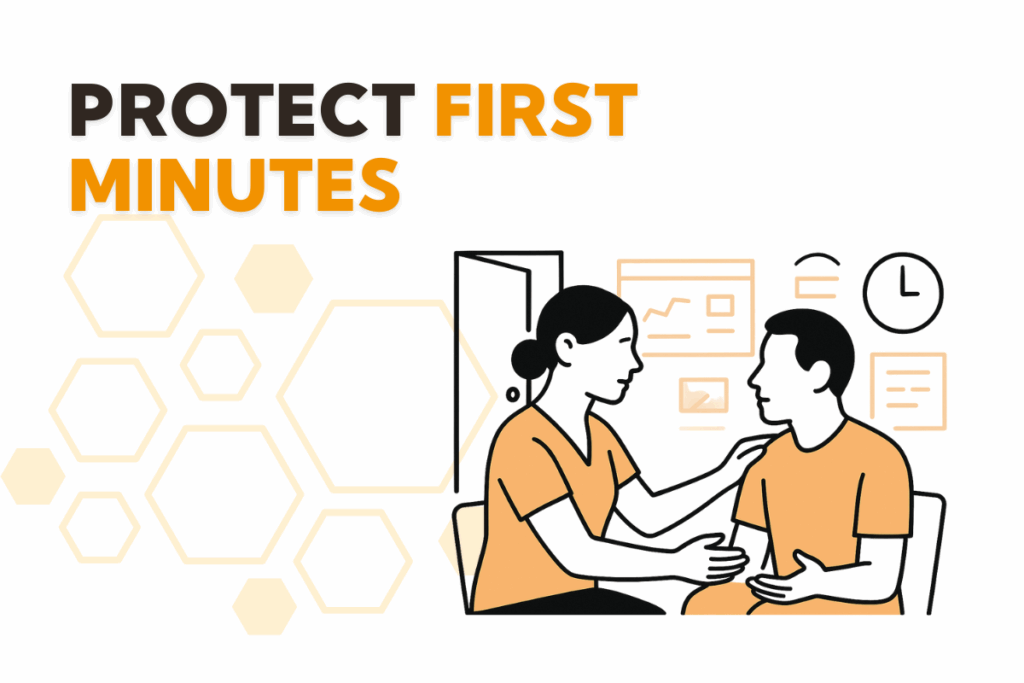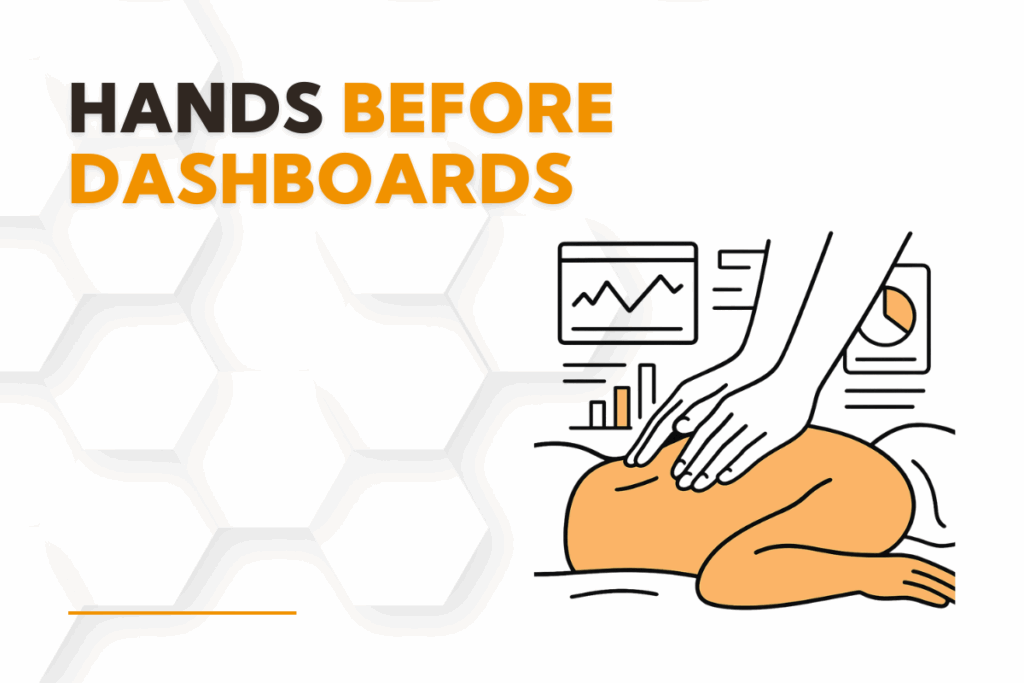Therapist-first clinic metrics belong in the first sentence because they name the real job: keeping hands-on care human while the schedule fills and the screens call for attention. You booked every slot this week and still felt the room go thin. Across many clinics, missed appointments and long lead times add silent rework, which means more time with dashboards and less time shaping a safe, effective session.
You chose hands-on care, not spreadsheet firefighting
You became a therapist to listen with your hands, not to reconcile five reports before lunch. Therapist-first clinic metrics exist to shrink the screen and strengthen the room. The problem is not data. The problem is distraction. Charts expand while the minutes that protect consent, pacing, and trust quietly shrink. A therapist-first frame brings the numbers back into service of care.
Why this tension changes outcomes
Massage therapy is relational. When first minutes are paced and goals are set in the client’s words, the body settles and a plan makes sense. When the start is rushed, pressure requests climb and rebooking softens. Therapist-first clinic metrics are designed to protect those first minutes so decisions and follow-through improve without asking you to stare at dashboards all day.
What dashboard creep looks like in a real clinic
You open a report to check rebooks and end up chasing a dip across three tabs. Intake becomes a checklist. Consent slides to a single question. Notes get shorter and less personal. Clients ask for deeper pressure because they did not feel seen at the start. The calendar looks full while the room feels thin. Therapist-first clinic metrics correct that drift by refocusing attention on the clinical rhythms that actually move outcomes.
The therapist-first metric shortlist
Keep data small and human
Three simple signals are enough when they are tied to action. Therapist-first clinic metrics keep you close to the work rather than trapped in analysis.
Return visits within 14 days
Track first-time clients separately. If this softens, the plan likely felt unclear. Bring back a simple close to each session and put the next step in the client’s own words. Therapist-first clinic metrics will reflect the change within a week or two.
Cancellation and no-show rate by time of day
Look for clusters. If evenings slip, test an earlier option or adjust reminder timing. With therapist-first clinic metrics, you are watching patterns you can influence, not punishing yourself with numbers you cannot control.
Minutes before hands-on
Protect the opening where goals, consent, and positioning are set. When this window shrinks, the entire session tilts. Therapist-first clinic metrics keep this number visible so you defend the space that creates safety.

Consent is not a checkbox. It is a rhythm.
Begin, revisit, confirm
Treat consent as an ongoing conversation. Start before first touch, check mid-session, and confirm any changes to technique or plan. For clear, client-centered guidance that aligns with Canadian standards, see the College of Massage Therapists of BC’s Consent Standard: https://cmtbc.ca/applicants/standards-of-practice/consent. Therapist-first clinic metrics support this rhythm by making the opening minutes visible and valued.
The “Monday 15” therapist QA loop
A short cadence that protects presence
Set a weekly 15-minute window. First, glance at your three signals and flag only one slip. Next, choose one small change you can run for five days. Finally, share the why with your team in a short note. The next Monday, keep what helped, drop what did not, and pick a new micro test. Therapist-first clinic metrics make this loop honest and light so improvement never swallows your week.
Playbooks you can use tomorrow
When return visits slip
Close each session with a plain next step and a suggested 10 to 14 day follow-up. Add that plan to the confirmation so expectations stay clear. Therapist-first clinic metrics will show the rebound as clients return on time.
When no-shows cluster at 5 to 7 pm
Offer an earlier option for commuters and send a same-day reminder three hours before the visit that includes what to bring and how to prep. With therapist-first clinic metrics tracking by time of day, you will see the pattern ease.
When minutes-before-hands-on keeps shrinking
Use a two-question intake that asks what hurts and what better by next week looks like. Keep charts closed for the first three minutes to protect attention. Therapist-first clinic metrics keep this number honest so the team guards it together.

Scripts that lower pressure and lift trust
Opening the session
Before we start, what would better by next week look like in your day.
Mid-session check-in
Pressure okay here, or should we slow and breathe for thirty seconds.
Closing with a next step
Based on today, let us meet again in about two weeks to keep working on shoulder control and sleep position. How does that timing feel.
Lead your team without losing the room
Share what matters, not more charts
Offer one short page each week that answers three things: what we noticed, what we changed, and what happened. Pin a single screenshot only if it clarifies the story. Tie every improvement to client language and the rhythm of the session. Therapist-first clinic metrics give owners clarity while therapists keep their craft.
Boundaries that keep tools in their place
Timebox admin and automate the background
Set one 15-minute review each week and keep dashboards closed between sessions. Let supportive tools carry the invisible load around your care. Streamline bookings with therapist online appointment scheduling so clients pick times without back-and-forth. Reduce preventable misses with clinic email text reminders so people arrive prepared and on time. Tools should serve the rhythm of care, not replace it. Therapist-first clinic metrics ensure automation supports presence instead of crowding it out.
A warm note from The Hivecommunity
Your value is not the number of charts you check. It is the way the room feels when someone finally exhales and trusts your plan. Keep therapist-first clinic metrics small and useful. Keep care warm and paced. Lead with your hands and let the numbers whisper.
FAQs
Fifteen minutes is enough for most therapist-led clinics. If your review takes longer, narrow your dashboard to the three signals and change only one thing per week. Therapist-first clinic metrics make that discipline easy.
Rates vary by community and lead time. Focus on patterns by time of day and adjust scheduling and reminders to remove friction. Therapist-first clinic metrics will show progress even before the month ends.
Everything from greeting to first touch. That includes goals in the client’s words, consent, positioning, and a few quiet breaths. Therapist-first clinic metrics protect this window so trust and outcomes improve.
You need a small, human set of signals that serve care. Track return visits within 14 days, no-shows by time of day, and minutes before hands-on. Review once a week, act once, and let therapist-first clinic metrics keep you honest.


